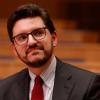Pope Francis on Thursday lashed out against high-level Catholic prelates who have been opposing his efforts to reform the Vatican's central bureaucracy, using an annual pre-Christmas meeting to say that while some cardinals and archbishops offer questions in a spirit of goodwill others practice a "malevolent resistance."
Such sinister opposition, the pontiff said, "sprouts from twisted minds and presents itself when the devil inspires bad intentions."
The pope also said it "finds refuge in tradition, in appearances, in formality, in the known, or in the desire to make everything personal without distinguishing between act, actor, and action."
Francis was speaking Thursday in an annual meeting that under previous pontiffs had simply been a polite encounter to exchange greetings before the holidays.
But in 2014 he shocked the Vatican bureaucracy, known as the Roman curia, by using the occasion to list off 15 "spiritual sicknesses" he said he had witnessed among them. In 2015, he offered what he called a "catalog of virtues" to help them overcome the sicknesses.
This year, the pope outlined 12 guidelines he is using in pursuing his reform of the curia. But he first again took the prelates to task, hitting back against those who have resisted his changes.
Besides those opposing malevolently, the pontiff identified cases of what he called "open" and "hidden" resistance.
Francis said open resistance is often "born of goodwill and sincere dialogue," but that hidden resistance is "born of fearful or hardened hearts content with the empty rhetoric of a complacent spiritual reform, on the part of those who say they are ready for change, but want everything to remain as it is."
The pope said that in undertaking reforms of the Vatican, people should see that the central command of the church "is not an immobile bureaucratic apparatus."
Using to the Latin phrase Ecclesia semper reformanda est ("The church is always to be reformed"), Francis said that in the changes at the Vatican people should see "first and foremost a sign of life, a Church that advances on her pilgrim way, a Church that is living and for this reason semper reformanda; in need of reform because she is alive."
"It is necessary to reiterate with force that the reform is not an end in itself but is a process of growth and most of all, conversion," said the pope.
"The reform, then, does not have an aesthetic end so as to make the curia more beautiful," he continued, saying it was not like applying make-up as a "trick to beautify the old curial body" or like undergoing plastic surgery to remove wrinkles.
"Dear brothers, it is not wrinkles that the church must fear, but moles!" the pontiff exhorted the cardinals and bishops.
"The reform will be effective only if it is carried out by 'renewed' men and not simply with 'new' men," said Francis. "It is not enough to content ourselves with changing the personnel, but we must bring members of the curia to renew themselves spiritually, humanly, and professionally."
"We need ... a permanent conversion and purification," the pope continued. "Without an alteration of mentality, the operational effort would be useless."
Francis then gave the prelates his 12 guidelines to reform: Individualism, pastoral concern, missionary zeal, clear organization, functionality, modernization, sobriety, subsidiarity, synodality, Catholicity, professionalism, and gradualism.
Taking up the theme of clear organization, the pope said that he needed to reorganize the different offices of the Vatican bureaucracy "on the basis of the principle that all Dicasteries are juridically equal."
"Each dicastery has its own areas of competence," he said. "These areas of competence must be respected, but they must also be distributed in a reasonable, efficient and productive way."
The pope addressed the theme of modernization using the Italian term aggiornamento, which means an "updating" and was made famous during the Second Vatican Council. He said such an updating "involves an ability to interpret and attend to 'the signs of the times.'"
In terms of synodality, Francis said a sense of a synodal approach to governance "must be evident" in the work of each Vatican office. The different offices, he said, "must avoid fragmentation caused by factors such as the multiplication of specialized sectors, which can tend to become self-referential."
Mentioning Catholicity, the pontiff said that each of the Vatican offices must be staffed by members that represent the diversity of the church in the different parts of the world.
The pope said he foresees "a greater number of laypeople, especially in those dicasteries where they can be more competent than clerics or consecrated people," and said "giving value to the role of women is also of great importance."
Francis ended his nearly 45-minute address with a list of 18 steps he has taken in the reform process so far, beginning with his creation of the advisory Council of Cardinals in April 2013 and ending with his approval of new statutes for the Pontifical Academy for Life in October 2016.
Among the most notable moves in the reform have been creation of three new overarching Vatican offices: the Secretariat for the Economy, which centralizes most of the city-state's financial offices; the Dicastery for Laity, Family and Life, which merged Vatican efforts on those issues; and the Dicastery for Promoting Integral Human Development, which will come into effect Jan. 1.
At the end of the meeting, Francis greeted the cardinals and bishops present one-by-one and gave each a copy of the book Tricks to cure the sicknesses of the soul by Jesuit Fr. Claudio Acquaviva, a 16th century Italian who was the fifth superior general of his order.
[Joshua J. McElwee is NCR Vatican correspondent. His email address is jmcelwee@ncronline.org. Follow him on Twitter: @joshjmac.]



